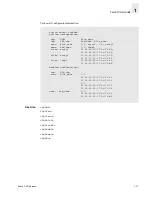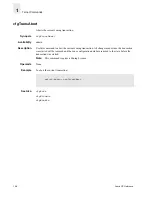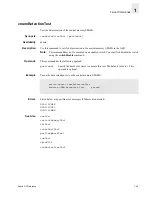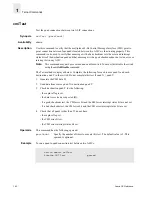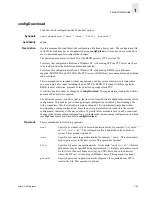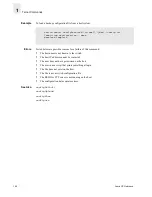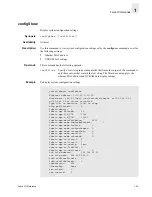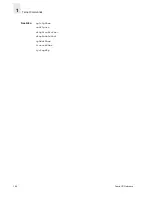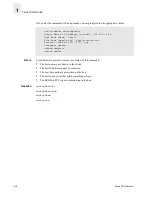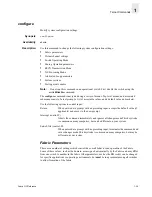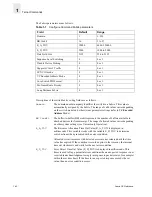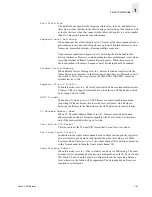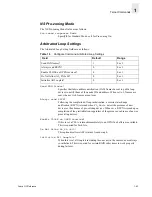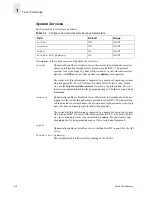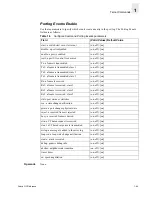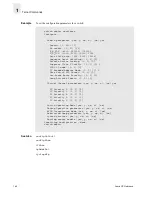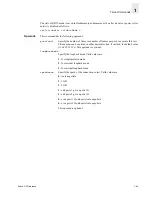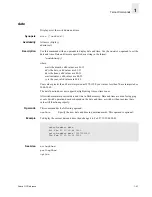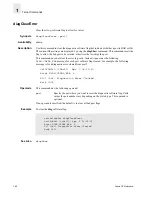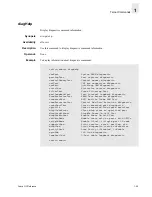
Fabric OS Reference
1-41
Telnet Commands
1
Data Field Size
The data field size specifies the largest possible value, in bytes, and advertises
this value to other switches in the fabric during construction of the fabric as well
as to other devices when they connect to the fabric. Setting this to a value smaller
than 2112 may result in decreased performance.
Sequence Level Switching
When Sequence Level Switching is set to 1, frames of the same sequence from a
particular source are transmitted together as a group. When this feature is set to 0,
frames are transmitted interleaved among multiple sequences.
Under normal conditions, Sequence Level Switching should be disabled for
better performance. However, some host adapters have performance issues when
receiving interleaved frames from multiple sequences. When there are such
devices attached to the fabric, Sequence Level Switching should be enabled.
Disable Device Probing
When Disable Device Probing is set to 1, devices that do not register with the
Name Server are not present in the Name Server data base. Set this mode only if
the switch
N_Port
discovery process (PLOGI, PRLI, INQUIRY) causes an
attached device to fail.
Suppress Class F Traffic
When this mode is set to 1, all class F interswitch frames are transmitted as class
2 frames. This is to support remote fabrics which involve ATM gateways which
don't support class F traffic.
SYNC IO mode
When Sync IO mode is set to 1, FSPF frames are sent in synchronous mode
(expecting ACKs back from the other side for every frame) which helps in
detecting the failures in the link between the ATM gateways in remote fabrics.
VC Encoded Address Mode
When VC Encoded Address Mode is set to 1, frame source and destination
address utilize an address format compatible with F16 switches. Set this mode
only if the fabric includes this type of switch.
Core Switch PID Format
This is used to set the 256 port PID format that is used for core switches.
Per-frame Route Priority
In addition to the eight virtual channels used in frame routing priority, support is
also available for per-frame based prioritization when this value is set. When
Per-frame Route Priority is set to 1, the virtual channel ID is used in conjunction
with a frame header to form the final virtual channel ID.
Long Distance Fabric
When this mode is set to 1, ISLs in a fabric can be up to 100Km long. The exact
distance level is determined by the per-port configuration on the E_Ports of each
ISL. Both E_Ports in an ISL must be configured to run the same long distance
level, otherwise, the fabric will be segmented. The Extended Fabric License is
required to set this mode.
Summary of Contents for StorageWorks 8B - FC Entry Switch
Page 1: ...reference manual version 3 0 fabric os www hp com ...
Page 14: ...xiv Fabric OS Reference ...
Page 189: ...Fabric OS Reference 1 175 Telnet Commands 1 portCfgLongDistance portCfgTrunkport portCfgSpeed ...
Page 302: ...1 288 Fabric OS Reference Telnet Commands 1 ...
Page 342: ...Index 4 Fabric OS Reference ...

